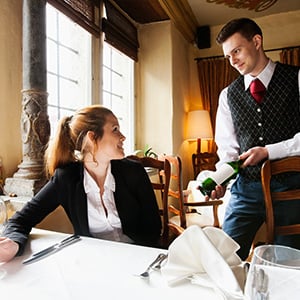
Regardless of a restaurant’s size or style, the serving staff represents the face of every dining establishment. These individuals have the most face time with your customers during their visit, and positive interactions can go a long way towards ensuring those same patrons return. Hiring the right employees for the job from the start is always ideal, but the introduction of a structured server training program can pay huge dividends for your business.
Server Training
By putting some thought and effort into a restaurant training program, you can immediately emphasize your workplace culture for every new hire and lower the turnover rate for your business. The following guidelines for restaurant server training will help you establish an effective, knowledgeable staff. Choose any of the steps below to read the section that most interests you:
-
- 1. Create a Server Handbook
- 2. Hold a Server Orientation for All New Hires
- 3. Set Goals for Server Training
- 4. Cross Train Your Servers
- 5. Shadow an Experienced Server
- 6. Hold a Menu Tasting
- 7. Perform Testing and Roleplay
- 8. Ongoing Training
- 9. Create Incentives
1. Create a Server Handbook

If you don’t have a server handbook yet, it’s a good idea to get one created. This restaurant training manual will serve as an important resource for new hires learning how to be a server as well as the rest of your established server staff. Provide a handbook to every server and keep one or two copies in the restaurant so anyone can reference it in times of need. A server training manual should include the following:
- Server Etiquette Guidelines – The scope of your etiquette may vary depending on the type of restaurant you own. For instance, fine dining has very specific guidelines that dictate every aspect of service. But on the whole, any type of restaurant customer service should emphasize politeness, humility, and the ability to anticipate the needs of your guests.
- Server Uniforms – Outline all dress code requirements in your guide, including expectations concerning uniforms, hair, jewelry, facial piercings, and finger nails. Some of these details are small, but they should be a large focus for any waitress training program. Make it a priority to discuss these things at length during servers’ training and ensure the appearance standards are clear.
- Server Scripts – How do you want your servers to introduce themselves to each new table? By providing a script for your serving staff you can help them to remember to share specific information about your establishment.
- How to Upsell – Not everyone is a salesperson, but upselling is a skill that can be learned. Share tips that will help your servers encourage guests to order appetizers, desserts, and upgrade cocktails with top-shelf liquor.
- Safety Policies – A busy restaurant is full of hazards and you can make sure your staff is safe at all times by outlining all of your safety policies. Stress the importance of wearing non-slip footwear and explain safe methods for carrying trays, ice buckets, bag-in-box sodas, or other heavy items. You should also include emergency procedures and fire exit routes.
2. Hold a Server Orientation for All New Hires
As a busy restaurant owner, it can be tempting to skip this step or delegate it to your managers. However, holding an orientation and meeting your new servers face to face goes a long way to building a workplace culture that encourages employees to work for you long term. These are some topics that you can discuss:
- Mission Statement and Company History – As the owner, this is your chance to share the mission statement of the restaurant with your new employees. By passing on information about what your business stands for and the values that you want to uphold, you can create a trickle-down effect. You would be surprised how often servers get questions from customers about when the business started and who owns it. This is your chance to make sure your servers are sharing your vision with your customers.
- Restaurant Concept and Culture – You probably put a lot of creativity and thought into your restaurant concept, but your new employees will need an introduction into your theme and how they can help support it. For instance, if your restaurant specializes in locally grown produce, you’ll want your staff to be educated about regional fruits and vegetables. If you own a BBQ restaurant with a blues music theme, you’ll want your staff to have some knowledge and appreciation for blues music.
- Tour the Building – By giving your new staff a tour of the restaurant prior to their first shift, you can help put them at ease. When they arrive on their first day, they’ll know which entrance to use, how to find the time clock, and where to keep their belongings.
3. Set Goals for Server Training
By setting training goals, you can create a standard that you’d like all servers to meet. This ensures that your program is consistent and every server gets the same level of restaurant training.
- Provide a Training Schedule – Before each server gets their own tables, they should complete your serving training program. Create a set schedule for your trainers to follow so that your new servers are hitting each step in the program. A sample schedule might last one week or two weeks, depending on the type of restaurant and style of your service.
- Create Benchmarks for Training – Make sure your training schedule has built-in benchmarks or small goals that each server should meet along the way. For example, after their first day of training they should be able to recite the permanent beer list, recount the company history, or memorize the table numbers.
4. Cross Train Your Servers

Cross training with other employees provides valuable insight into how a particular restaurant operates. Before new servers start working with your waitstaff training team, it can be very helpful to have them train with some other key positions first.
- Cross Train with Hosts / Hostesses – The host team are experts on the layout of your dining room, how to use your reservation software, and how to rotate tables so guests receive the best service possible. By spending a couple shifts working with the host team, a server will quickly learn the dining room sections and the numbers of each table. They’ll also be capable of attending to any guests that walk through the door, in the absence of a host or hostess.
- Cross Train with Food Runners – The next training session should be with a food runner so that your new servers can apply the knowledge they just learned about the dining room in a different application. They should know where each table is and be able to deliver food to the correct guest. This training session is also an introduction to your menu and what the different food items look like.
5. Shadow an Experienced Server
Before completing the training program, your new servers should perform a few shadowing sessions with your most experienced servers. You can designated a certain number of required training sessions, or rely on your trainer’s judgement as to how many are needed. During these sessions, the new server is essentially an assistant and any of the tips that are earned go to the trainer. The trainer should go over the following topics:
- How to Take Orders – After completing a training session with the food runners, your new servers will have a better sense of the most popular food items on your menu when it comes time to interact with guests. They should practice taking orders for each table, with the trainer acting as a guide if any questions pop up.
- How to Use the POS System – A big part of transitioning to a new restaurant is learning how to use the POS system. Trainers should show the new server how to use the system, then give them hands-on experience entering all the orders for the shift.
- Sidework Rotation – In addition to serving guests, servers also have sidework duties that must be performed during every shift. These duties usually consist of prep work like cutting lemons, stocking the salad bar, or stocking beverage stations. At the end of the shift they should make sure all the tables in their section are clean and that condiments are full.
- Learn Where Items are Stocked – Servers will need to retrieve various items from dry and cold storage during a shift. It’s very helpful to point out the location of items like glass racks, ice buckets, and take-out containers so they can be found quickly.
- Restaurant Layout – During waiter or waitress training, be sure to identify key routes to the most important parts of the facility. Additionally, your staff will always want to be aware of the surroundings, so point out potential problem areas as well. This can include high traffic locations or places which could contain one or two “blind spots” for servers carrying full trays of food.
- How to Close Out – The close out procedure includes everything a server needs to do before they can end their shift. To close out of the POS system, a server needs to print their sales for the shift and turn their cash into a manager. They’ll also need to use their sales to tip out any bartenders, bussers, or food runners. Sometimes a server will be designated as a sidework checker and will have to sign off on each servers’ sidework.
6. Hold a Menu Tasting
One of the best parts about server training is trying out the menu items. Servers can’t answer questions or make recommendations if they’ve never tasted the food. At the conclusion of server shadowing, the trainer should sit down and do a menu tasting with the new server(s). This is a great time to sample a variety of the most popular food items, go over the most commonly asked menu questions, and discuss allergen information. It’s also a celebratory moment because training is almost complete.
Even the most descriptive of menus still require clarification from time to time, and your wait staff should be as familiar as possible with the menu. The best serving staff should be able to not only explain in detail each menu item, but also provide suggestions, recite any daily specials with ease, and answer a customer’s questions.
7. Perform Testing and Roleplay

The last step before a new server can work independently is to pass a final test. For some restaurants, this test might be very lengthy if there is a lot of memorization involved, as with extensive wine or beer lists.
- Written Test – This test could cover everything from menu knowledge to policies in your handbook. It should include everything you think is vital for your servers to know.
- Roleplay – Require the new server to wait on a manager before their training is complete. With this method, a variety of common interactions can be touched on, all within the span of just a few minutes. In addition, this method can prepare new staff members with the proper responses to complaints or upset customers.
8. Ongoing Training
Several of these guidelines, such as your restaurant layout and the menu, may change over time, so it’s important to use all of these teaching points as part of ongoing training sessions for all your servers. By implementing an ongoing training program, you have the opportunity to increase productivity, update policies to comply with new industry regulations, and improve job satisfaction in a work area that’s often high in employee turnover. Some specific things to make part of long-term training include:
- Learning which menu items are most popular, least expensive, most expensive, etc.
- Acquiring knowledge of weekly or daily specials
- Successfully selling guests on appetizers or desserts
- Finding the right balance between too much and too little interaction with guests at their table
- Improving awareness and multi-tasking skills
- Reading personalities/attitudes and determining exactly which kind of service the guest desires
9. Create Incentives
Make sure your serving staff stays engaged by offering incentives for performance. You can reward servers that participate in ongoing training sessions with free meals, preferred parking spots, or raises. Keep track of server wins like the highest alcohol or appetizer sales and give out a gift card to the winner each week. There are many ways to incentivize performance and create a fun work environment for your servers.
Single-event training can often be forgotten or seem overwhelming for a new employee on the first day. By creating and following a detailed training program, you can set your new employees up for mutual success. Ongoing training allows for employers to evaluate and follow-up effectively in order to get the most out of their staff. This type of restaurant server training can help propel your operation to the next level of professional, award-winning service.
Source: Webstaurantstore.com